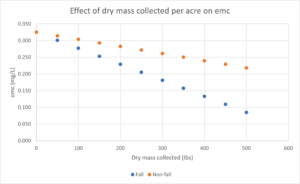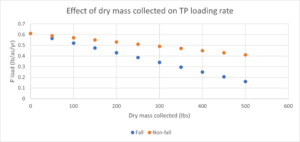
Difference between revisions of "Accounting for phosphorus load reductions with street sweeping"
m (→Mass reduced) |
m (→Mass reduced) |
||
| Line 24: | Line 24: | ||
| Loading rate reduction (lb/ac/yr) || 0.128 | | Loading rate reduction (lb/ac/yr) || 0.128 | ||
|} | |} | ||
| + | |||
| + | ==Adjusting emcs== | ||
| + | [[File:Dry mass effect on emc.png|300px|thumb|left|alt=Image Effect of dry mass collected with street sweeping on event mean concentration|<font size=3>Effect of dry mass collected with street sweeping on event mean concentration. Conditions: One acre of residential land use using default values in MPCA Simple Estimator and in MPCA Street Sweeping Tool</font size>]] | ||
| + | [[File:Dry mass effect on loading rate.png|300px|thumb|alt=Image Effect of dry mass collected with street sweeping on loading rate|<font size=3>Effect of dry mass collected with street sweeping on loading rate. Conditions: One acre of residential land use using default values in MPCA Simple Estimator and in MPCA Street Sweeping Tool</font size>]] | ||
| + | |||
| + | If a model is being used to track phosphorus loading, reductions in mass can be used to adjust the event mean concentration (emc). These adjustments assume a linear relationship between mass of P reduced and the emc. | ||
| + | |||
| + | In the above example, the emc could be adjusted if the initial loading rate was known. For example, if the initial loading rate was 1.00 lb/ac/yr, the P reduction was 12.8 percent of this and the emc could be adjusted accordingly. | ||
| + | |||
| + | Because the emc adjustment is a function of the initial emc, it would be useful to establish relationships between sweeper mass collected and the resulting effect on emc for specific land uses that have a recommended default emc. For example, the MPCA Simple Estimator has a default of 0.325 mg/L TP for residential land use. Using the default values of 30.65 in/yr precipitation and 0.27 for runoff coefficient, the resulting annual TP load is 0.61 lb/ac/yr. | ||
| + | |||
| + | We ran several scenarios using the MPCA Sweeping Tool and established the following relationship between sweeper mass collected (dry mass) and the effect on emc and loading rate. The results are shown below. Similar relationships could be established for other land uses that have recommended emcs. | ||
Revision as of 16:11, 23 March 2021
Many stormwater models do not directly calculate reductions in phosphorus loading associated with street sweeping. P8 and Winslamm are exceptions, though P8 bases reductions on TSS reductions, which likely underestimates reductions because most of the phosphorus loading is likely associated with organic debris. When reporting on phosphorus reductions, stormwater practitioners and permittees need to translate collection of street sweeping debris with a reduction in phosphorus loading.
This page provides some methods for accounting for phosphorus reductions associated with street sweeping.
Mass reduced
The simplest method for tracking reductions associated with sweeping is to estimate or measure the mass of phosphorus reduced. If tracking on a per acre basis is needed, the mass reduced must be determined per unit land area (e.g. per acre).
For example, using the MPCA Street Sweeping tool, assume the following data is collected. The resulting load reduction is 0.64 pounds of phosphorus, or 0.128 lb/ac/yr.
| Area swept (acres) | 5 |
| Dry mass collected (non-fall) | 500 |
| P reduction (non-fall) | 0.21 |
| Dry mass collected (fall) | 500 |
| P reduction (fall) | 0.43 |
| Total P reduced (lbs) | 0.64 |
| Loading rate reduction (lb/ac/yr) | 0.128 |
Adjusting emcs
If a model is being used to track phosphorus loading, reductions in mass can be used to adjust the event mean concentration (emc). These adjustments assume a linear relationship between mass of P reduced and the emc.
In the above example, the emc could be adjusted if the initial loading rate was known. For example, if the initial loading rate was 1.00 lb/ac/yr, the P reduction was 12.8 percent of this and the emc could be adjusted accordingly.
Because the emc adjustment is a function of the initial emc, it would be useful to establish relationships between sweeper mass collected and the resulting effect on emc for specific land uses that have a recommended default emc. For example, the MPCA Simple Estimator has a default of 0.325 mg/L TP for residential land use. Using the default values of 30.65 in/yr precipitation and 0.27 for runoff coefficient, the resulting annual TP load is 0.61 lb/ac/yr.
We ran several scenarios using the MPCA Sweeping Tool and established the following relationship between sweeper mass collected (dry mass) and the effect on emc and loading rate. The results are shown below. Similar relationships could be established for other land uses that have recommended emcs.

